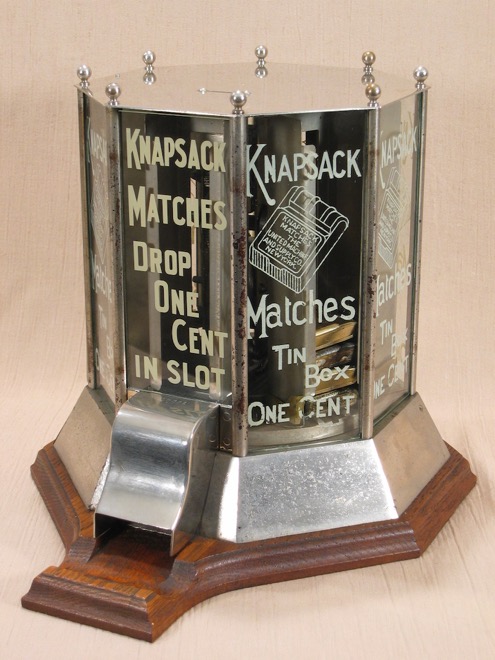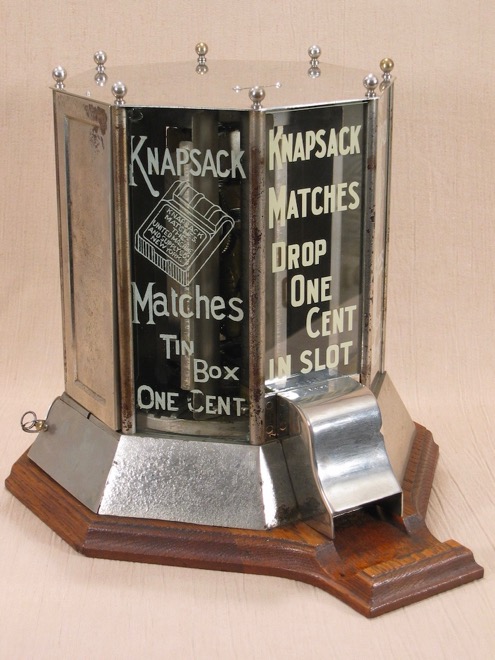___________________________________________________________________________________________
Knapsack Matches


___________________________________________________________________________________________


United Machine and Supply Co., New York, c. 1902, 11" (including the small knobs on top). This is an elegant Rube Goldberg-inspired model that I'm kinda surprised ever made it to the market. The 8-sided body houses 6 columns that hold canisters of matches---more about the canisters below---around the perimeter of the machine's body, with a lot of empty space in the middle. This design spreads the machine's stock more horizontally than do the designs of most other vendors, which typically stack matches into fewer but taller and closely-spaced columns. The Knapsack approach produces a much larger footprint than those of most other match vendors, which I can't imagine was a selling point for the machine.
All but a few match vendors have simple designs that require the customer to insert a penny and then push or turn something to move a thin cardboard box of wood safety matches to the exit point (see Northwestern Sellem and Pix Safety Matches as examples). The Knapsack has a clockwork mechanism that does Oh So Much More. It works like this: The customer inserts penny, which trips the mechanism to release a canister from the column in front. When the last canister is dispensed from that column, the machine somehow knows the front column is now empty and it rotates the entire bank of columns 60 degrees so that the next column is then positioned in front. Is that cool, or what? I've not tried to figure out how the machine knows the last canister was just dispensed from the front column, and I won't try to figure it out because it would probably mean removing the top, the glass panels, and the posts between the glass panels, and I don't want to risk screwing something up. I've learned the hard way from experience to leave well enough alone, and if ain't broke then don't break it.
Removing the tall metal panel on the machine's right side allows access to the stacks for refilling and to the winder nub for rewinding. That panel can be removed by first removing the short slanted panel below it, where the key is sticking out. When the short slanted panel is in place it locks the tall panel in its place. Removing the short slanted panel also reveals a deep storage area under the floor of the mechanism, where the long winder can be safely tucked away between refillings.
About those canisters: Except for the Knapsack, all match vendors I know of sold wood safety matches in small boxes made of thin cardboard, or sold cardboard matches contained in a thin cardboard matchbook. The latter type is the kind in use when I was a kid, the kind that requires you to tear off a small match from a cardboard spine. It's the kind that had advertising on it, which often gave clues to private eyes in 1940s crime movies (Close-up of a matchbook being held by a man's hand, with voiceover: "Nelly's Bar, huh? Maybe I'll pay them a visit tomorrow, see what they know about this dame." Fade to next scene.). In contrast, the Knapsack sold wood safety matches in tin canisters embossed with the Knapsack name. I don't know the business rationale for that, but it certainly added a layer of complexity and cost to their inventory. I've been told that 2 sizes of Knapsack canisters exist, but I haven't confirmed it. The machine can handle only one size, so if Knapsack made 2 sizes then one of them must have been used for another purpose.
So wrapping this up: Compared to other match vendors, the Knapsack is much more complicated, undoubtedly was more expensive to buy, requires more counter space, and locks the vendor into using Knapsack matches in tin canisters that were also probably more expensive to buy. I suspect the phrase "Sounds great, I'll take 2 dozen of 'em" was not one ever heard by a Knapsack salesman. Given the commercial disadvantages, I suspect this model had a short life so it's not surprising that it's listed as rare in Silent Salesmen Too. I've seen or heard of enough of these to question that, but only mildly. I don't dispute it, but I'm not 100% sure it's Officially Rare. Examples are quite scarce, though, and if they're not Officially Rare then I'm sure they border on that designation.
The example pictured above is 100% original except for the following:
___________________________________________________________________________________________
___________________________________________________________________________________________
©Small Vintage Vending 2019